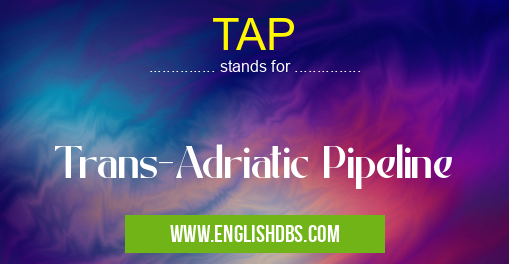What does TAP mean in ACADEMIC & SCIENCE
TAP is a 878 kilometers (546 miles) long natural gas pipeline that transports natural gas from the Shah Deniz II field in Azerbaijan to Italy. It is the final segment of the Southern Gas Corridor, a major energy infrastructure project that aims to diversify Europe's natural gas supply sources.

TAP meaning in Academic & Science in Academic & Science
TAP mostly used in an acronym Academic & Science in Category Academic & Science that means Trans-Adriatic Pipeline
Shorthand: TAP,
Full Form: Trans-Adriatic Pipeline
For more information of "Trans-Adriatic Pipeline", see the section below.
- TAP (Trans-Adriatic Pipeline) is a natural gas pipeline that transports Caspian gas from Greece to Italy, via Albania.
- It is a key component of the Southern Gas Corridor, a major infrastructure project aimed at diversifying Europe's energy supply.
TAP's Importance
- Enhanced Energy Security: TAP provides Europe with an alternative gas supply route, reducing its dependence on Russian gas.
- Economic Growth: The pipeline supports economic growth in the countries it traverses, creating jobs and boosting local businesses.
- Environmental Benefits: Gas transportation via pipeline is a more environmentally friendly option compared to other modes of transport, such as LNG tankers.
Route and Technical Specifications
- The pipeline stretches approximately 878 kilometers (546 miles) from the Greek-Turkish border to the Italian coast.
- It is designed to operate at a maximum pressure of 100 bar (1,450 psi).
- The pipeline's capacity is 20 billion cubic meters (bcm) of gas per year.
Ownership and Financing
- TAP is owned by a consortium of leading energy companies, including:
- BP
- SOCAR (State Oil Company of Azerbaijan Republic)
- Snam
- Fluxys
- Enagás
- The project was financed through a combination of equity and debt, with the European Investment Bank (EIB) providing significant support.
Environmental and Social Considerations
- TAP has implemented comprehensive measures to minimize its environmental impact, including measures to protect biodiversity and minimize noise pollution.
- The project also includes a social investment program to support local communities along the pipeline's route.
Essential Questions and Answers on Trans-Adriatic Pipeline in "SCIENCE»SCIENCE"
What is the Trans-Adriatic Pipeline (TAP)?
Where does the TAP pipeline start and end?
TAP starts at the Greek-Turkish border, where it connects to the Trans-Anatolian Pipeline (TANAP), and ends in Melendugno, Italy.
What is the capacity of the TAP pipeline?
TAP has a transportation capacity of up to 10 billion cubic meters (bcm) of natural gas per year.
Who are the main stakeholders in the TAP project?
The main stakeholders in the TAP project are: BP (20%), SOCAR (20%), Snam (20%), Fluxys (19%), Enagás (16%), and Axpo (5%).
What is the environmental impact of the TAP pipeline?
TAP has been designed to minimize its environmental impact. The pipeline route was carefully chosen to avoid sensitive areas, and construction methods were implemented to protect the environment. TAP also has a comprehensive environmental monitoring program in place to ensure that the pipeline does not have any negative impacts on the environment.
What are the economic benefits of the TAP pipeline?
TAP will provide Europe with a new source of natural gas, which will help to reduce dependence on Russian gas. The pipeline will also create jobs and boost economic growth in the countries that it passes through.
When did the TAP pipeline become operational?
TAP became operational in December 2020.
Final Words: TAP is a strategic energy infrastructure project that enhances Europe's energy security, promotes economic growth, and has a positive impact on the environment. Its successful implementation underscores the importance of collaboration and innovation in meeting Europe's energy needs.
TAP also stands for: |
|
| All stands for TAP |
